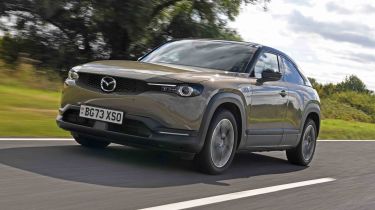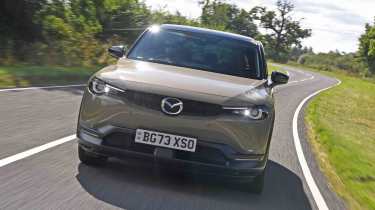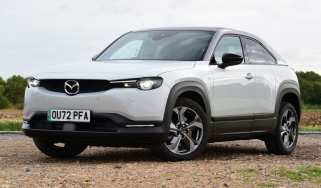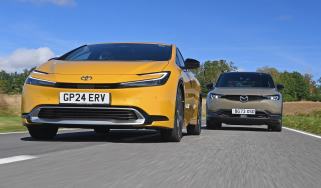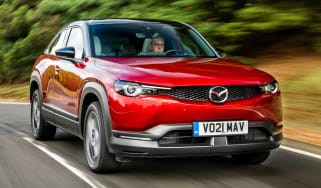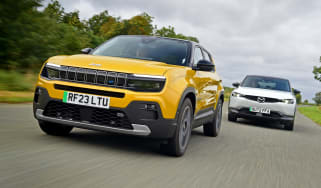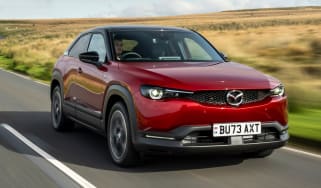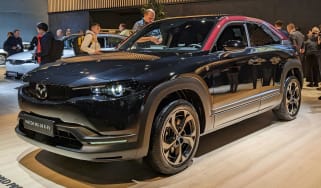Mazda MX-30 review
Stylish Mazda handles well and has a classy cabin but is compromised elsewhere, whether in electric or range-extending guise

Is the Mazda MX-30 a good car?
One thing’s for certain: the Mazda MX-30 is definitely a stand-out car in many ways, but not all of them are necessarily a good thing. Its compact dimensions mean it’s more of a crossover than a full SUV, and the rear-hinged half doors emphasise this - but they do also compromise practicality.
The Mazda MX-30 was the brand’s first fully electric car but is now also available in R-EV form with some interesting engineering under the bonnet: a tiny rotary petrol engine that charges the battery and turns the car into a range-extender hybrid. Given that the electric MX-30 was always hampered by its poor range figures, this model should offer a bit more flexibility and usefulness to those who plan to use their car for more than just commuting.
It’s the first time that Mazda has fitted a rotary unit in one of its cars since the RX-8 coupe, but unlike past models, this isn’t a sports car but a family model using it for efficiency.
|
Key specs | |
|
Fuel type |
Electric, range-extending PHEV |
|
Body style |
Five-door crossover |
|
Powertrain |
35.5kWh battery, 1x 143bhp e-motor, front-wheel drive |
|
Safety |
Five stars Euro NCAP (2020) |
|
Warranty |
3yrs/60,000 miles, 8yrs/100,000 miles (battery) |
How much does the Mazda MX-30 cost?
With prices starting at less than £30,000, the Mazda MX-30 is one of the better-value electric SUVs currently available. However, the reason it costs so little is because of the small battery that Mazda has fitted to the car – it cost less to make, so the firm can list it for less, but that’s also the reason why it has such a short range.
More reviews
Car group tests
- Toyota Prius vs Mazda MX-30: a Japanese hybrid car clash
- Jeep Avenger vs Mazda MX-30: left-field electric SUVs face off
- Mazda MX-30 vs Kia Soul EV
Long-term tests
Road tests
Used car tests
If you’re interested in the R-EV instead, like-for-like you’ll have to find an extra £3,500 to get behind the wheel. For some that will be a big enough price to pay for the added reassurance of the range-extending petrol engine.
The range runs through Prime-Line, Exclusive-Line and Makoto trims, with a step of around £2,000 to move to Exclusive-Line, then another £2,500 for the Makoto model. All versions of the MX-30 come with LED headlamps, heated electric folding mirrors, front and rear parking sensors, a reversing camera and rain-sensing wipers.
Inside, there’s an 8.8-inch infotainment system that’s controlled by a central rotary knob and panel of buttons. Apple CarPlay and Android Auto are included, while Mazda’s Connected Services with the MyMazda app offers remote control over vehicle functions and relays charging information back to your phone.
Electric motors, performance & drive
Compact dimensions and a small battery help the Mazda MX-30 to deliver a relatively engaging driving experience when compared with other electric vehicles. It helps that Mazda has a philosophy of making cars that are lighter than average to deliver fun handling, too. Things are less rosy for the R-EV model, because the extra weight of the range-extending running gear means it’s not quite as composed as the EV. Read more about the Mazda MX-30's electric motors, performance & drive…
Range, charging & running costs
Mazda made a conscious decision to only offer a modest battery in the MX-30 that would be enough for short commutes and not a lot else. This shouldn’t be an issue if you’re able to charge the car every time it’s parked, but might be inconvenient if you do longer journeys. The R-EV model alleviates range anxiety, but only really makes sense if you can charge the battery regularly – and you’ll still have to visit a petrol station on occasion, too. Read more about the Mazda MX-30's range, charging and running costs…
Interior, design & technology
The MX-30’s interior design will be familiar to anyone who’s driven a recent Mazda, so the layout is logical and build quality is great. Mazda has stuck with a separate control wheel and shortcut buttons that operate the central touchscreen, while the addition of cork trim to the centre console adds some quirkiness and is a nod to Mazda’s manufacturing history. Read more about the Mazda MX-30's interior, design and technology…
Boot space, comfort & practicality
Access to the MX-30’s interior is made tricky by the rear-hinged half doors – we know it’s a nod to the RX-8 sports car, but that doesn’t make them any less of a faff to use. Once inside, the front cabin is fine to get comfortable in, with plenty of seat adjustment, but the back seats are cramped. This is offset by the boot, which is a good size. Read more about the Mazda MX-30's boot space, comfort and practicality…
Reliability & safety
A five-star Euro NCAP safety rating was awarded to the MX-30 in 2020, and it comes with a range of safety features to help prevent and mitigate collisions. However, you have to choose the top-spec Makoto model if you want rear traffic detection and braking support when reversing. Mazda has a decent reputation when it comes to reliability, so there shouldn’t be any concerts with the MX-30. Read more about the Mazda MX-30's reliability and safety…
Mazda MX-30 alternatives
With its limited range and compact dimensions, there isn’t really a direct alternative to the Mazda MX-30. The car is similar in size (if not price) to Mazda’s own CX-30, so small SUVs such as the Hyundai Kona and Kia Niro could be considered, although both of those cars easily outrank the MX-30 for range.
Looking at the MX-30 price wise, and it equals the likes of the Fiat 500e and Vauxhall Corsa Electric. It also has similar cabin space to those two, although there is a larger boot on offer.
The MX-30 R-EX is also a fairly unique proposition, because most of its plug-in rivals are hybrids, rather than being range-extending models. Of these, the latest Toyota Prius offers quirky looks, while cars such as the VW Golf eHybrid, Peugeot 308 and Vauxhall Astra are more conventional (and therefore more user-friendly) in their five-door hatchback design.
Frequently Asked Questions
R-EV stands for Range-Extending Vehicle, and this version of the MX-30 is the one with a petrol engine on board. It’s a rotary unit (similar to the engines used in the RX-7 and RX-8 sports cars), so it’s compact, while it acts as a generator that recharges the battery; it never actually drives the wheels directly. There’s a smaller battery in the R-EV to make room for the range-extending running gear, but there’s a theoretical range of around 400 miles, compared with the 124 miles possible in the electric MX-30.

